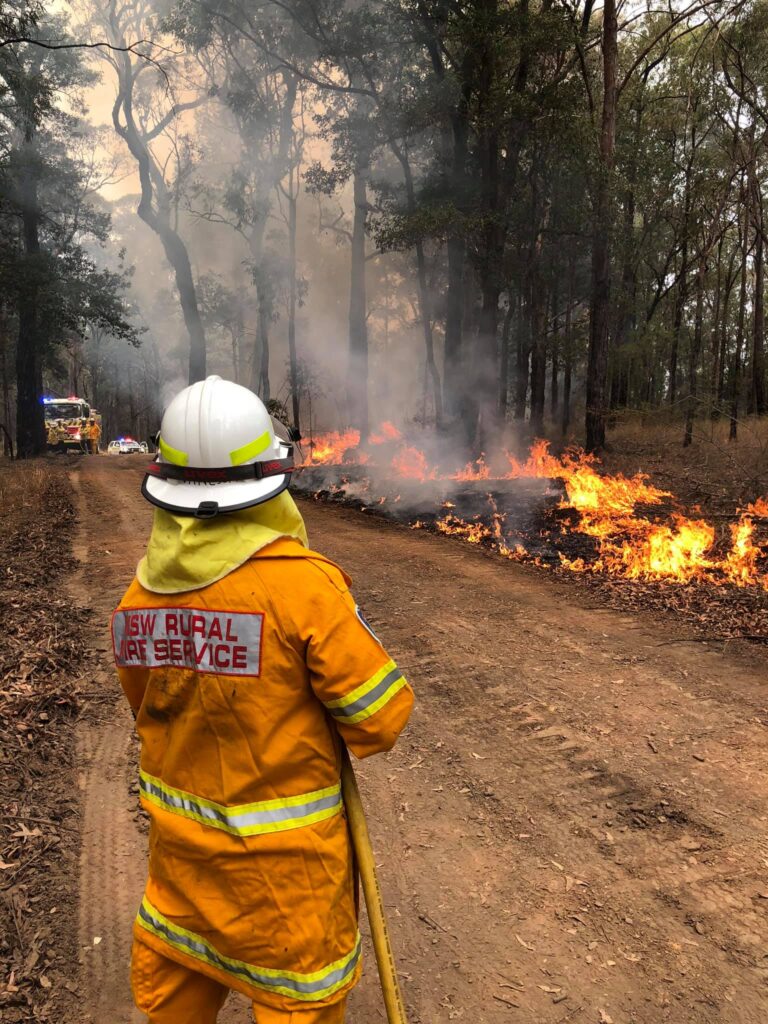Five years ago, as devastating wildfires raged across Australia, Hayley Stone, a policy director for a national advocacy group, stepped away from her desk for five weeks to help contain the blazes. Driven by a desire to give back to her community, Stone volunteers for the Rural Fire Service (RFS), attending meetings and training sessions in her free time. During times of crisis, the volunteers hit pause on their normal jobs in order to assist Australia’s large paid firefighting force, combining soft skills such as teamwork and crisis management with practical firefighting.
In 2019, Stone’s team was called to action — first on the New South Wales coast and then closer to home, when a fire in the Blue Mountains began rapidly spreading due to dry, hot and windy conditions.
“For weeks at a time the sky was a different color,” Stone says. “We were constantly dealing with smoke — you’re just living with that constant smell.”
The fire came within about 30 miles of her hometown before it was finally brought under control.

In order to fight the fires, Stone used her five weeks of paid annual leave. Under the Australian government’s National Employment Standards, workers are also entitled to five weeks of unpaid community service leave for “voluntary emergency management activities,” including firefighting.
For non-emergency volunteer work with charities and other community service organizations, employees are generally expected to find the time outside of working hours — unless the activity is supported by an internal company volunteering initiative.
With many employees looking for purpose beyond the usual 9-to-5 grind, giving them opportunities to volunteer on company time can help them connect with their communities, build a sense of purpose outside of work and acquire new skills. In Australia and other regions experiencing large-scale natural disasters, volunteering on the clock can also save lives, homes and the environment.
As company volunteering becomes increasingly popular, it raises important HR and payroll considerations such as how to track volunteer hours, integrate a volunteer program into the workplace and ensure those hours are used effectively.
Company-supported volunteering
Over the past 50 years, companies have embraced corporate social responsibility (CSR) initiatives that include employee volunteer programs. CSR benefits both the community and the company; researchers have found that companies with CSR programs are more profitable, enjoy better brand reputation, and have employees who are more engaged. ESG — environmental, social and governance — programs take CSR one step further, providing measurable goals surrounding an organization’s social impact.
With the advent of ESG, volunteering programs are on the rise, as organizations are more aware of their impact and workers are increasingly purpose-driven. In a recent Deloitte survey, almost 90% of millennials and Gen Z said having a sense of purpose is important to their overall job satisfaction and well-being.
“Workplace volunteering meets community needs and produces social outcomes, while also producing built-in results that contribute positively to employee engagement, reputation, trust and team building,” says Kari Niedfeldt-Thomas, the Managing Director and Chief Operating Officer at Chief Executives for Corporate Purpose (CECP). The organization’s research has found that company trust nearly doubles when employees engage in volunteer activities with high social impact.
Many corporate volunteer programs align with the business’s goals and skills, or are tailored to the local community’s unique needs. They can take a variety of forms and use different terminology, but generally paid volunteer leave is called Volunteer Time Off, or VTO. Employees in organizations offering VTO typically receive 8 to 40 hours of annual leave, regardless of their level within the organization, and have more flexibility in choosing where to volunteer. Today, an estimated 40% of U.S. companies offer VTO.
In a Structured Corporate Volunteering (SCV) initiative, the company organizes group volunteer days with specific organizations, either during work hours or on employees’ days off.
Negotiating volunteer time
During the Covid-19 pandemic, many HR and payroll departments learned to work with heightened agility. These rapid-response processes can be adapted in any emergency situation to allow employees to take volunteer leave, whether paid or unpaid. The key is for companies to have clear policies in place around VTO notice and approvals.
In Stone’s case, even though Australian law guarantees emergency volunteer leave, employees still need to provide managers with notice and an estimate for how long they will be gone. This information is then passed on to their payroll officer.
Stone suggests employees and managers have open conversations well in advance about the nature of their volunteer work. In small organizations such as hers, prolonged absences have a serious impact on the rest of the team.
“What I’d really like is to be able to negotiate with employers to be able to have that flexibility to be able to just say, ‘Look, I’m sorry, I will give you a week’s notice, and then I’m going to have to go off and do a deployment,’” she says.
I’ve picked up some amazing new skills that I never thought that I would have, and I feel a lot more connected to the community.
Stone chose not to extend her deployment after her paid leave ran out, even though the crisis hadn’t ended and she was legally entitled to additional unpaid leave. As a manager, she was concerned that being gone for too long would hurt the organization.
“It wasn’t a decision that I took lightly,” she says.
Over six months, Stone’s brigade of 40 firefighters logged more than 10,000 hours of volunteer time, including both training sessions after work and deployments to fight fires during normal working hours.
“That’s the equivalent of 426 days worth of work — all given in a volunteer capacity,” she says. “I’ve picked up some amazing new skills that I never thought that I would have, and I feel a lot more connected to the community.”

Read more
Sign up to keep up to date with ReThink Q.








